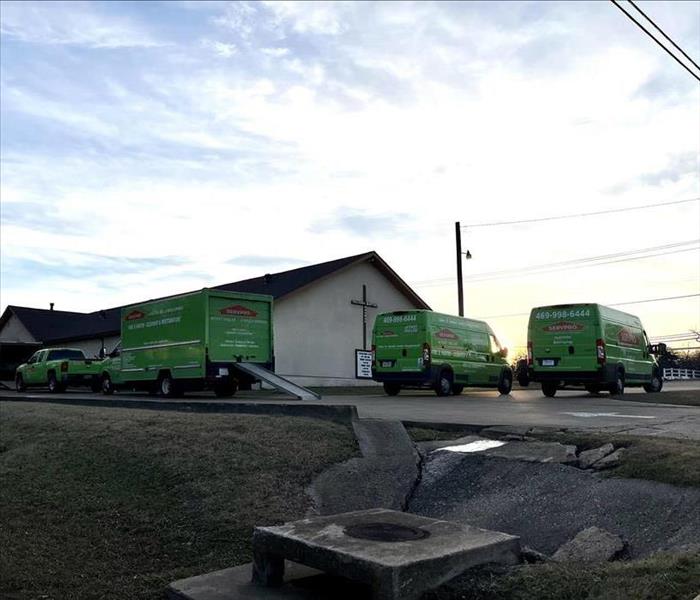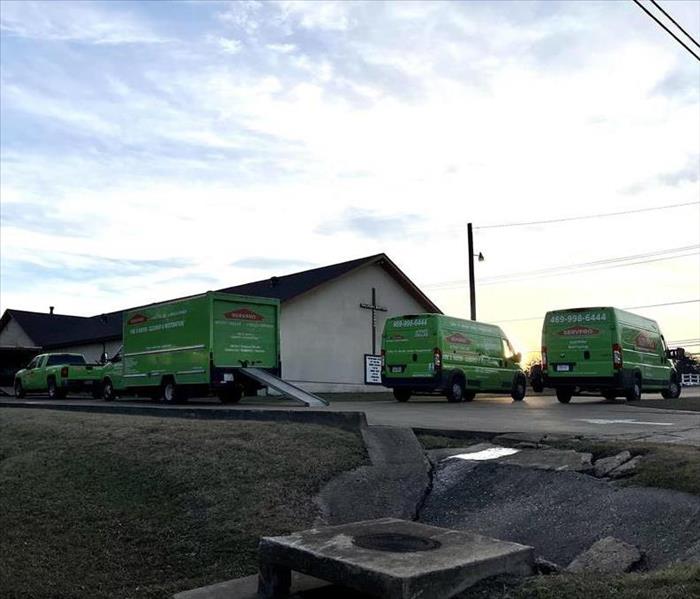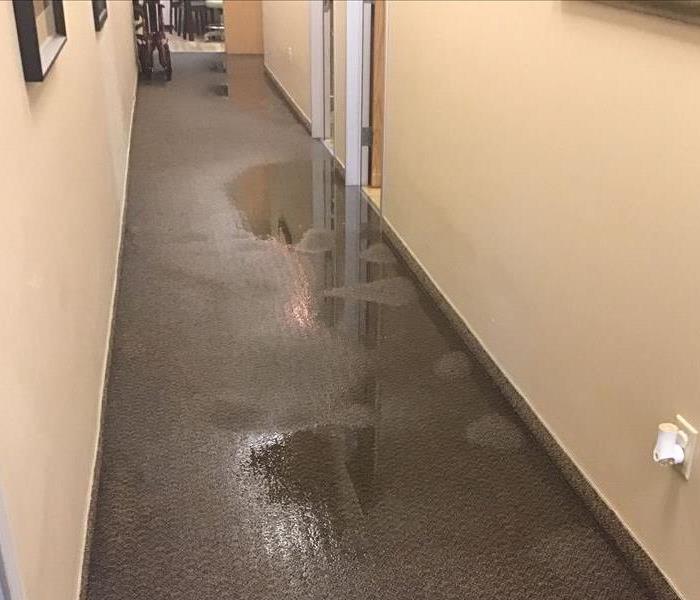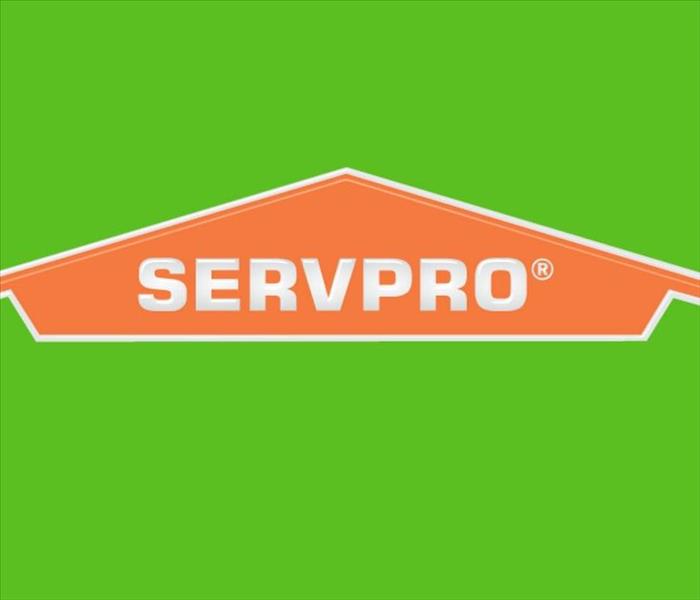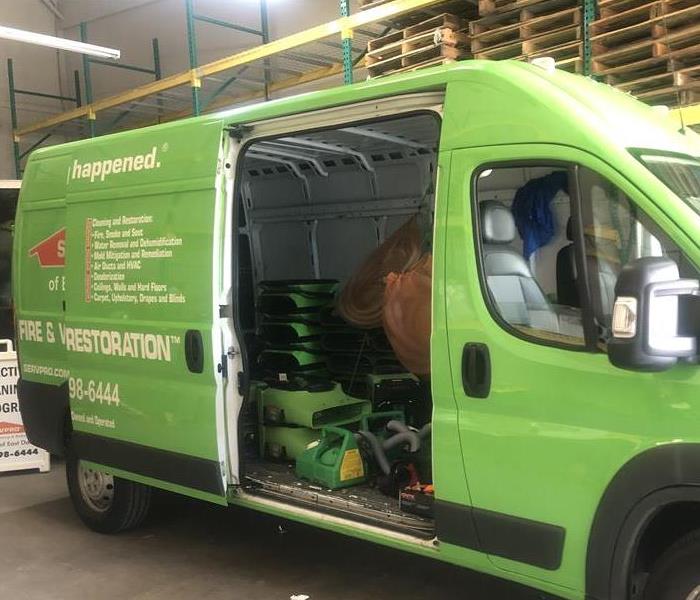Recent Water Damage Posts
SERVPRO of East Dallas Trusted Fire Damage Repair
7/16/2024 (Permalink)
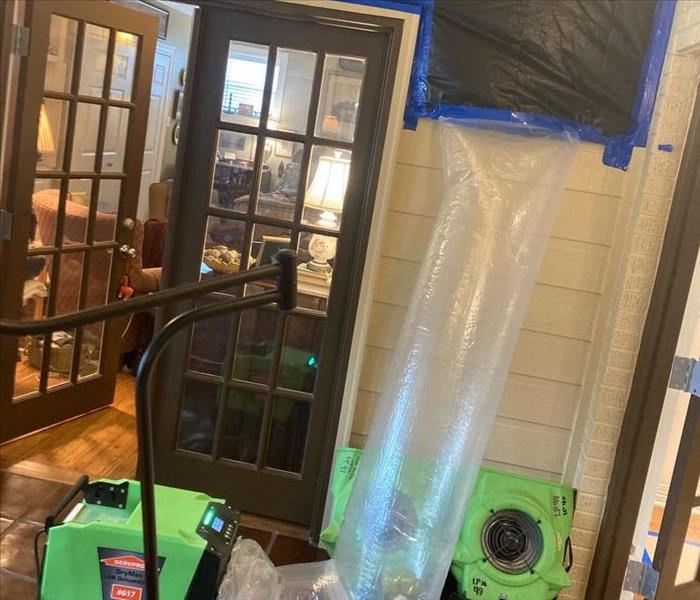 SERVPRO of East Dallas is a trusted leader in fire damage repair services.
We are located in Dallas, so we are able to reach Dallas quickly!
SERVPRO of East Dallas is a trusted leader in fire damage repair services.
We are located in Dallas, so we are able to reach Dallas quickly!
Understanding Fire Damage in Dallas Homes
SERVPRO of East Dallas is located in Dallas & offers a unique blend of vibrant city life and close-knit community vibes. However, like any major urban area, homes in Dallas are not immune to the devastating effects of fire. Whether due to a cooking accident, electrical malfunction, or even a wildfire, fire damage can leave your home in ruins and your life in turmoil.
Fire Damage Can Happen in Dallas
When a fire strikes, the immediate aftermath can be overwhelming. The damage extends beyond what the flames touch, including smoke damage, soot residue, and water damage from firefighting efforts. Here's a breakdown of the types of damage you might encounter:
- Structural Damage: This includes burned walls, ceilings, and floors. The structural integrity of your home might be compromised, requiring professional assessment.
- Smoke and Soot Damage: Smoke can infiltrate every nook and cranny, leaving behind a pervasive odor and discoloring surfaces. Soot can cover surfaces with a fine, oily residue that is difficult to clean.
- Water Damage: The water used to extinguish the fire can soak into carpets, walls, and furniture, leading to potential mold growth if not properly addressed.
Steps to Take After a Fire
Ensure Safety: Before re-entering your home, ensure it is safe to do so. Contact local authorities and wait for their approval.
Contact Your Insurance Company: Report the fire to your insurance company as soon as possible. Document the damage with photos and keep a detailed inventory of affected items.
Secure the Property: Board up windows and doors to prevent further damage from weather or theft.
Professional Assessment: Hire a licensed fire damage restoration company in Dallas. They will assess the damage, create a plan for cleanup and repairs, and help you navigate the insurance claims process.
Fire Damage Restoration Process
Assessment and Inspection: Restoration professionals will evaluate the extent of the damage, including structural, smoke, soot, and water damage.
Water Removal and Drying: Using industrial-grade dehumidifiers and air movers, the team will remove water and dry affected areas to prevent mold growth.
Smoke and Soot Cleanup: Specialized equipment and techniques are used to clean surfaces and remove smoke odor.
Restoration and Reconstruction: This involves repairing or replacing damaged structures, repainting, and restoring your home to its pre-fire condition.
Experiencing a fire in your Dallas home can be a traumatic event, but understanding the steps to take and having a plan for recovery can make a significant difference. Remember, the key to effective recovery is immediate action, professional help, and preventive measures to ensure the safety of your home and loved ones in the future.
Why Rainwater isn't Always Safe
5/1/2024 (Permalink)
Rainwater, that natural elixir from the skies, has long been romanticized for its purity and freshness. But beneath its seemingly pristine facade lie hidden risks that often go unnoticed. While rainwater can be a valuable resource in certain contexts, particularly for watering plants or washing cars, it's essential to recognize that it's not always safe for consumption or other uses. In this blog post, we'll delve into the reasons why rainwater isn't always as harmless as it appears.
1. Contamination from the Atmosphere:
Contrary to popular belief, rainwater isn't as pure as it seems. As it falls from the sky, rainwater can pick up various pollutants and contaminants present in the atmosphere. These pollutants include dust, dirt, pollen, chemicals from industrial processes, and even microorganisms such as bacteria and viruses. Consequently, rainwater collected directly from rooftops or open containers can contain a cocktail of harmful substances that pose health risks if ingested or used for household purposes without proper treatment.
2. Roof Contaminants:
The surface from which rainwater is collected plays a significant role in its quality. Many people collect rainwater from rooftops, which may seem like a logical choice due to its large surface area. However, roofs can harbor a multitude of contaminants that leach into the rainwater. These contaminants can include bird droppings, dust, mold, algae, and chemicals from roofing materials such as asbestos or lead-based paints. Without adequate filtration or treatment, rainwater collected from rooftops can be far from safe for consumption.
3. Risk of Bacterial and Viral Infections:
Rainwater, especially when collected in stagnant containers, can become a breeding ground for bacteria, viruses, and other pathogens. Mosquitoes, for example, are attracted to standing water and can lay their eggs in rain barrels or other collection systems. This increases the risk of mosquito-borne diseases such as West Nile virus and dengue fever. Moreover, bacteria such as E. coli and Salmonella can thrive in untreated rainwater, leading to gastrointestinal infections if ingested.
Balch Springs Drying Equipment
4/24/2024 (Permalink)
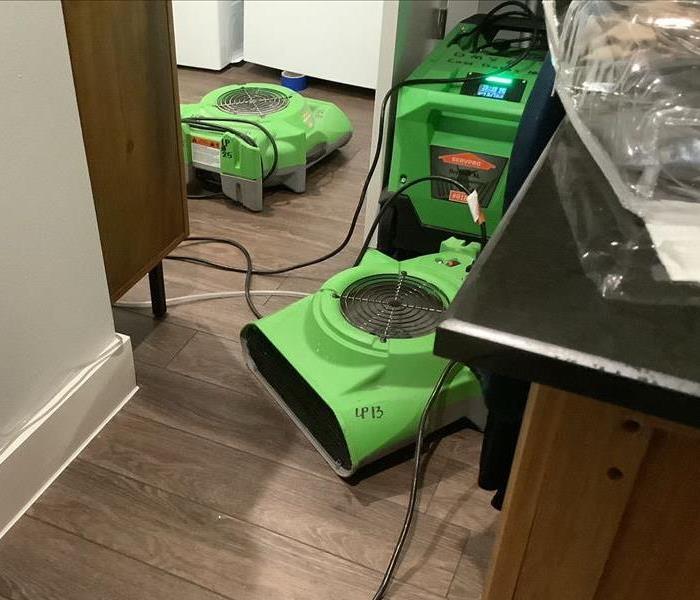 We'll work closely with you to develop a customized cleanup plan that meets your needs and exceeds your expectations.
We'll work closely with you to develop a customized cleanup plan that meets your needs and exceeds your expectations.
Don't wait to start the cleanup process – contact us today to learn more about our fire damage cleanup services and take the first step toward restoring your property to its former glory. Together, we'll rebuild and renew, one step at a time. ???? #FireDamageCleanup #RapidResponse #WeRestoreHope
Dangers of Water Damage in Your Kitchen
4/22/2024 (Permalink)
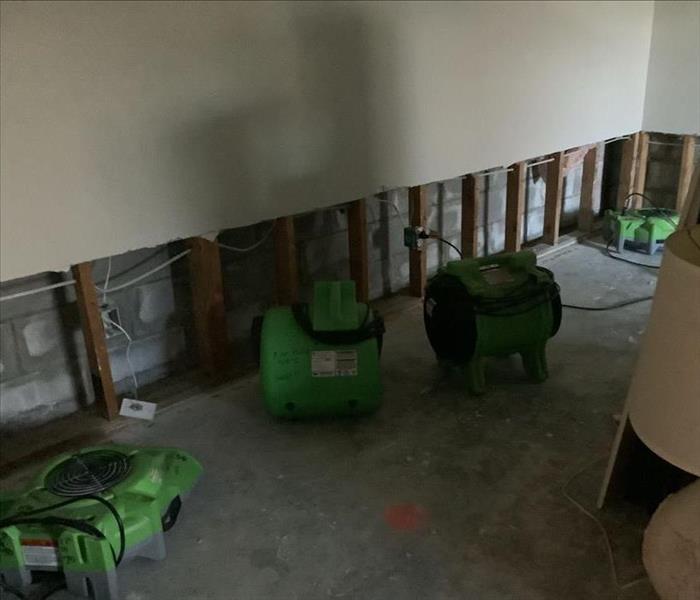 SERVPRO of East Dallas has seen kitchens suffering with water damage. Thankfully we have the knowledge and equipment to handle any size disaster.
SERVPRO of East Dallas has seen kitchens suffering with water damage. Thankfully we have the knowledge and equipment to handle any size disaster.
Water damage in the kitchen can pose various dangers and risks, both to the structure of the house and the health of its occupants. Here are some potential dangers associated with water damage in the kitchen:
Structural Damage: Water can seep into floors, walls, and ceilings, leading to structural damage such as rotting wood, weakened drywall, and compromised foundation. Over time, this can cause significant structural issues and compromise the integrity of the building.
Mold Growth: Moisture from water damage creates an ideal environment for mold growth. Mold can proliferate rapidly within 24 to 48 hours of water exposure, spreading on surfaces and releasing spores into the air. Mold not only damages surfaces but also poses health risks, as mentioned earlier.
Electrical Hazards: Water damage in the kitchen can affect electrical wiring, outlets, and appliances, leading to electrical hazards such as short circuits, electrical fires, or electrocution. Water and electricity are a dangerous combination and should be addressed promptly by professionals.
Slip and Fall Accidents: Water accumulation on kitchen floors due to leaks or flooding increases the risk of slip and fall accidents. This is particularly hazardous in a room where people frequently move around, carry objects, or stand on slippery surfaces.
Appliance Malfunction: Water damage can affect kitchen appliances such as refrigerators, dishwashers, and ovens, causing them to malfunction or stop working altogether. This not only disrupts daily routines but also poses safety risks if appliances malfunction unexpectedly.
Pest Infestation: Standing water and moisture in the kitchen attract pests such as cockroaches, ants, and rodents. These pests not only cause sanitation issues but also pose health risks and may further damage the property.
Water Contamination: Depending on the source of water damage, there is a risk of water contamination. For example, if the water comes from a sewage backup or a contaminated source, it can introduce harmful bacteria, viruses, or chemicals into the kitchen environment, increasing health risks for occupants.
Decreased Property Value: Untreated water damage can significantly decrease the value of a property. Potential buyers may be deterred by the prospect of dealing with existing damage or the possibility of hidden issues that could emerge later.
Addressing water damage promptly and thoroughly is crucial to mitigate these dangers and prevent further harm to both the property and its occupants. This often requires professional assistance to assess the extent of the damage, identify and fix the source of the water intrusion, and carry out necessary repairs and restoration work.
The Restoring Process Explained in Simple Terms! Enjoy!
2/8/2024 (Permalink)
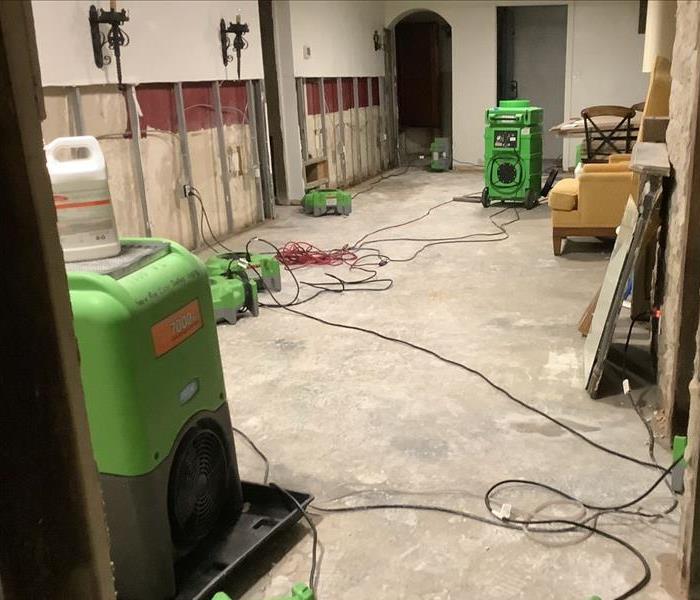 SERVPRO of Balch Springs equipment hard at work at a Balch Springs library. We will keep you updated!
SERVPRO of Balch Springs equipment hard at work at a Balch Springs library. We will keep you updated!
Water damage can wreak havoc on your home, causing structural issues, mold growth, and damage to your belongings. Whether it's from a burst pipe, a leaking roof, or a natural disaster, swift action is crucial to mitigate the damage and restore your home to its preloss condition. In this guide, we'll walk you through the comprehensive water damage restoration process.
1. Assessment and Inspection:
The first step in water damage restoration is a thorough assessment and inspection of the affected areas. Trained professionals will evaluate the extent of the damage, identify the source of the water intrusion, and categorize the water based on its contamination level (clean, grey, or black water).
2. Water Extraction:
Once the assessment is complete, the next step is water extraction. Industrial-grade pumps and vacuums are used to remove standing water from the premises. This step is essential for preventing further damage and mold growth.
3. Drying and Dehumidification:
After water extraction, the drying process begins. High-powered fans and dehumidifiers are strategically placed to remove moisture from the air and surfaces. This helps prevent secondary damage and inhibits mold growth.
4. Cleaning and Sanitizing:
All affected surfaces and belongings are thoroughly cleaned and sanitized to eliminate any traces of contamination and prevent microbial growth. This may involve using antimicrobial solutions and specialized cleaning techniques.
5. Restoration and Repairs:
Once the area is completely dry and sanitized, restoration and repairs can begin. This may involve replacing damaged drywall, flooring, insulation, and other structural components. The goal is to restore your home to its preloss condition, both aesthetically and functionally.
6. Mold Remediation:
In cases where mold growth is present, specialized mold remediation techniques are employed to safely remove mold colonies and prevent recurrence. This may include containment, air filtration, and the use of antimicrobial agents.
7. Monitoring and Follow-Up:
Even after the restoration process is complete, monitoring is essential to ensure that there are no lingering issues or signs of water damage. Follow-up inspections may be conducted to verify the effectiveness of the restoration efforts and address any concerns.
Conclusion:
Water damage restoration is a complex process that requires expertise, equipment, and swift action. By following these steps and enlisting the help of experienced professionals, you can mitigate the damage, restore your home, and regain peace of mind. Remember, when it comes to water damage, time is of the essence, so don't hesitate to seek help at the first sign of trouble.
Cleaning Water Damage in Floors
12/27/2023 (Permalink)
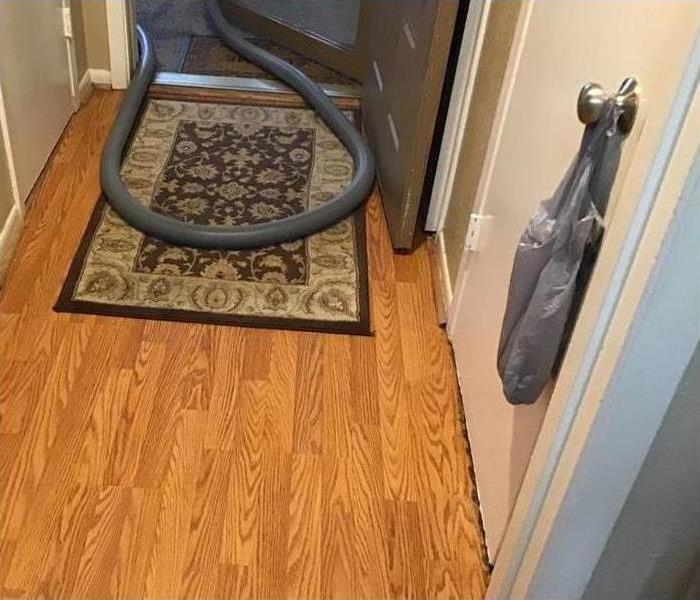 SERVPRO of Balch Springs is here to help your next water damaged floors!
SERVPRO of Balch Springs is here to help your next water damaged floors!
Cleaning water-damaged floors is a critical step in the restoration process to prevent further damage and potential health issues. The approach to cleaning will depend on the type of flooring you have. Here are general guidelines for cleaning water damage from different types of floors:
Safety First:
- Turn Off Power: Before beginning any cleanup, ensure that the power to the affected area is turned off to prevent electrical hazards.
- Wear Protective Gear: Use personal protective equipment such as gloves, boots, and, if necessary, a mask to protect yourself from potential contaminants in the water.
Remove Standing Water:
- Use a Wet/Dry Vacuum: Extract as much standing water as possible using a wet/dry vacuum. Make sure to use a vacuum designed for water removal.
- Mop and Towels: Mop the remaining water and use absorbent towels or rags to soak up moisture from the floor.
Ventilation:
- Promote Air Circulation: Open windows and doors to increase ventilation and aid in the drying process. Use fans and dehumidifiers to reduce humidity levels.
Carpeted Floors:
- Extract Water from Carpet: Use a carpet extractor or wet/dry vacuum specifically designed for carpets to remove water.
- Lift and Remove Carpet: If possible, lift the carpet to allow air circulation and expedite drying. Remove the carpet padding, as it is difficult to dry and can harbor mold.
- Clean and Disinfect: Clean the carpet with a carpet cleaner and disinfect the area to prevent mold growth.
Hardwood Floors:
- Remove Water: Wipe down the hardwood floors with a dry, absorbent cloth or towel to remove as much water as possible.
- Gently Clean: Clean the floor with a mixture of mild soap and water. Avoid using excessive water, as it can seep into the wood and cause damage.
- Dehumidify: Use dehumidifiers to remove excess moisture from the air and the wood.
Tile and Vinyl Floors:
- Remove Water: Wipe down the surface with absorbent towels or rags to remove standing water.
- Clean with Mild Detergent: Clean the floor with a mixture of mild detergent and water. Use a soft brush or mop to avoid scratching the surface.
- Dry Thoroughly: Ensure that the grout lines are dry, as moisture in the grout can lead to mold growth.
Concrete Floors:
- Remove Water: Use a wet/dry vacuum to extract water from the concrete floor.
- Clean and Disinfect: Clean the floor with a mild detergent or a mixture of bleach and water to disinfect the surface.
- Dry Completely: Ensure thorough drying by using dehumidifiers and promoting air circulation.
Check for Mold:
- Inspect for Mold Growth: After cleaning and drying, inspect the area for any signs of mold growth. If mold is present, take appropriate measures to address it promptly.
- Consider Professional Inspection: For extensive water damage or if you suspect hidden moisture, consider hiring professionals for a thorough inspection and remediation.
Monitor and Prevent Future Issues:
- Continue Monitoring: Keep an eye on the affected area for any signs of lingering moisture or new issues.
- Prevent Future Water Damage: Identify and address the root cause of the water damage to prevent future incidents. This may involve fixing leaks, improving drainage, or installing protective measures.
Always follow the manufacturer's guidelines for cleaning and maintaining specific types of flooring. If the water damage is extensive or you are uncertain about the best approach, consider seeking professional assistance to ensure a thorough and effective cleanup.
Let's Prepare For A Dallas Winter
11/16/2023 (Permalink)
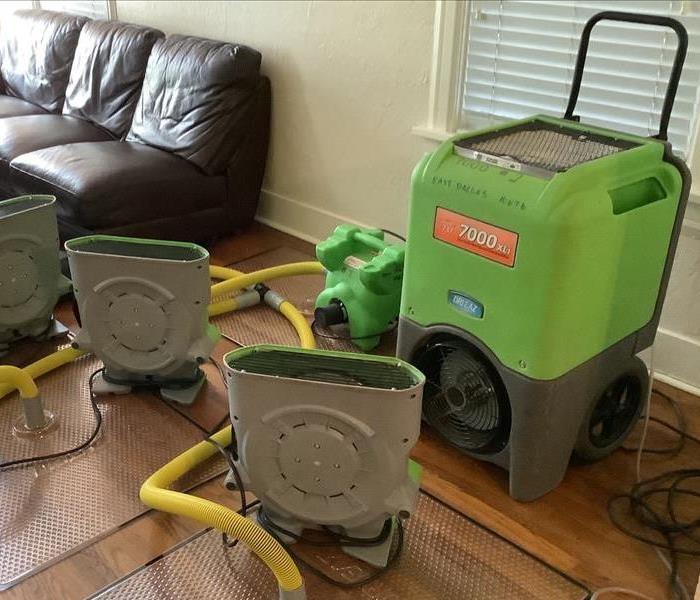 SERVPRO of East Dallas is here to help all of Dallas & surrounding areas. We specialize in water/fire/mold damage repair.
SERVPRO of East Dallas is here to help all of Dallas & surrounding areas. We specialize in water/fire/mold damage repair.
SERVPRO of East Dallas is here to help prevent tips to stop frozen pipes. Preventing frozen pipes is crucial, especially in colder climates. Here are some tips to help you avoid frozen pipes:
Insulate Exposed Pipes:
- Insulate pipes in unheated areas such as basements, crawl spaces, and attics.
- Use pipe insulation or heat tape to wrap pipes. This helps retain heat and prevent freezing.
Seal Leaks:
- Seal any gaps or cracks in walls, windows, and doors to prevent cold air from entering and reaching your pipes.
Keep Interior Doors Open:
- Allow warm air to circulate freely through your home by keeping interior doors open. This helps maintain a consistent temperature.
Let Faucets Drip:
- Allow faucets to drip slowly during extremely cold weather. This prevents pressure buildup in the pipes, reducing the risk of freezing.
Maintain a Consistent Temperature:
- Keep your home heated to a consistent temperature, especially at night. Even if you're away, don't let the temperature drop too low.
Use Space Heaters:
- Place space heaters in areas where pipes are more susceptible to freezing, but use them with caution, following safety guidelines.
Open Cabinet Doors:
- Open cabinet doors under sinks to allow warm air to reach pipes. This is particularly important in kitchens and bathrooms.
Disconnect Garden Hoses:
- Disconnect and drain outdoor hoses before winter. Close the inside valves that supply outdoor hose bibs and keep them open outside to let any remaining water drain out.
Insulate Exterior Walls:
- Insulate exterior walls to help maintain a warmer temperature within the home.
Install a Smart Thermostat:
- Use a smart thermostat to monitor and control the temperature remotely. Some smart thermostats can alert you if the temperature drops significantly.
Drain the Water System if Away:
- If you're going away during the winter, consider draining your water system to prevent pipes from freezing. Alternatively, set the thermostat to a minimum temperature.
Apply Heat Tape:
- Use heat tape on vulnerable pipes. Follow the manufacturer's instructions for proper installation.
Professional Inspection:
- If you have concerns about the vulnerability of your plumbing system to freezing, consider consulting a professional plumber for an inspection and advice.
Remember that prevention is key, and taking these measures before the onset of winter can save you from the inconvenience and potential damage caused by frozen pipes.
When Flooding Water Needs Up Being Too Much
11/16/2023 (Permalink)
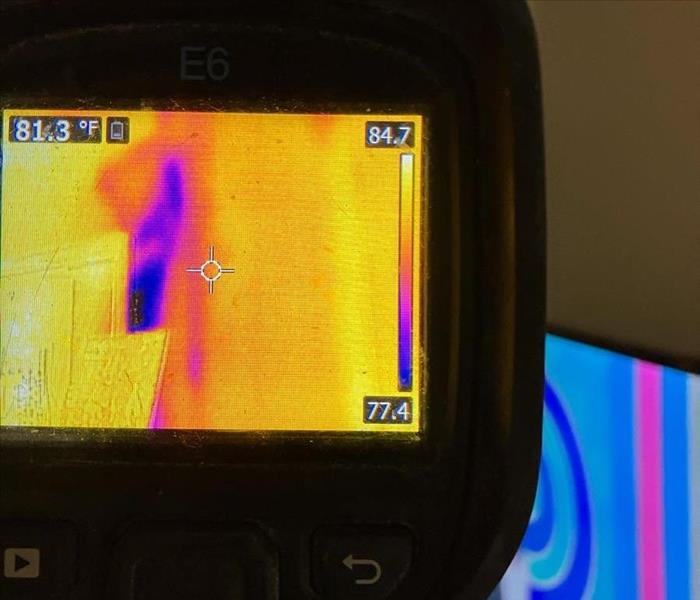 SERVPRO of East Dallas has been a staple in the remediation world.
SERVPRO of East Dallas has been a staple in the remediation world.
Dallas isn't protected from floods, we have had our own fair share of flooding water. Leaving flooding water untreated can have various adverse consequences for both the environment and human health. We hope you never know into this problem, but leaving flooded water in a home over time will cause damage by the hour.
Contamination:
- Floodwater can be contaminated with various pollutants, including sewage, chemicals, debris, and bacteria. This contamination poses significant health risks to humans and animals.
Waterborne Diseases:
- Untreated floodwater may contain harmful microorganisms, such as bacteria, viruses, and parasites, which can cause waterborne diseases. Exposure to contaminated water can lead to illnesses like gastroenteritis, cholera, and other infections.
Structural Damage:
- Floodwater can cause structural damage to buildings and infrastructure. It can weaken foundations, erode soil around structures, and damage walls, floors, and electrical systems.
Mold Growth:
- Standing water and high humidity resulting from flooding create favorable conditions for mold growth. Mold can develop in as little as 24 to 48 hours, leading to potential respiratory problems and other health issues.
Damage to Belongings:
- Personal belongings, furniture, and valuables can be irreversibly damaged if left in contact with untreated floodwater. The water can cause warping, rusting, and deterioration of materials.
Environmental Impact:
- Floodwater carries pollutants and debris into rivers, lakes, and other bodies of water, causing environmental damage. It can harm aquatic ecosystems, contaminate drinking water sources, and affect wildlife.
Mosquito Breeding:
- Stagnant floodwater provides an ideal breeding ground for mosquitoes. This can lead to an increase in mosquito-borne diseases such as West Nile virus and dengue fever.
Long-Term Health Effects:
- Exposure to untreated floodwater and its contaminants can result in long-term health effects, especially if individuals do not seek medical attention promptly. Respiratory issues, skin infections, and other health problems may develop over time.
Loss of Agriculture:
- Flooding can damage crops and farmland, leading to the loss of livelihoods for farmers and potential food shortages.
Infrastructure Challenges:
- Flood damage to roads, bridges, and other infrastructure can disrupt transportation and communication systems, making it difficult for emergency services to reach affected areas.
SERVPRO of East Dallas hopes that you don't run into a flooded home, however if this situation rises we must find a water to extract water as soon as possible.
Water Damage Cleaning Tips for Balch Springs
7/25/2023 (Permalink)
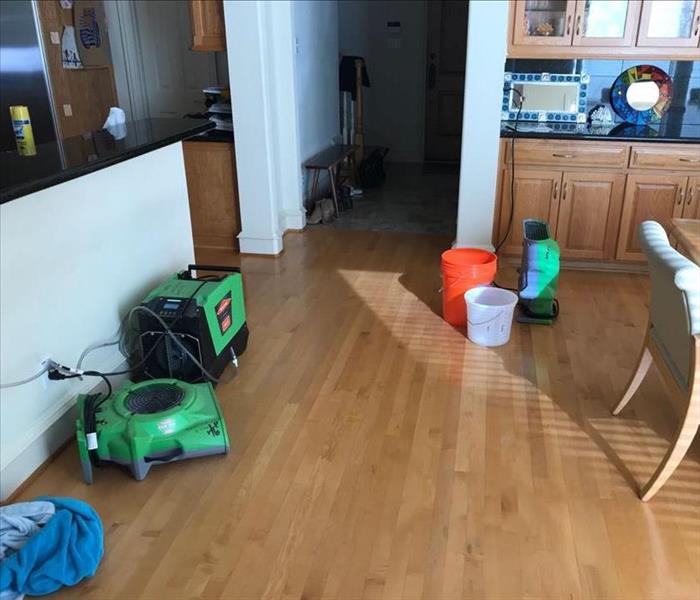 Water Damage Affected floors can ruin your home within days.
Water Damage Affected floors can ruin your home within days.
Dealing with water damage can be challenging and requires prompt action to prevent further damage and potential health hazards. Here are some general water damage tips to help you address the situation effectively:
1. Ensure safety: Before entering a water-damaged area, make sure it's safe to do so. Turn off electricity to the affected area to avoid the risk of electric shock.
2. Stop the source: If the water damage is caused by a leak or burst pipe, try to identify and stop the source of the water if it's safe to do so. This will help prevent additional water from entering the area.
3. Protect yourself: Wear protective gear, such as rubber gloves, boots, and a mask, when dealing with water damage, especially if the water is contaminated.
4. Remove standing water: Use a wet/dry vacuum, buckets, or mops to remove as much standing water as possible. The sooner you can extract the water, the better chance you have of minimizing damage.
5. Dry the area: Use fans, dehumidifiers, and open windows to promote air circulation and aid in the drying process. This helps prevent mold growth, which can begin within 24 to 48 hours after water damage.
6. Salvage valuable items: Remove furniture, personal belongings, and other items from the affected area to a dry location. Salvage what you can and discard severely damaged items.
7. Disinfect: If the water damage is caused by contaminated water (e.g., sewage backup or flooding), disinfect the area to prevent the spread of harmful bacteria and pathogens. Use a mixture of water and bleach (1 cup of bleach per gallon of water) for this purpose.
8. Check for hidden damage: Water can seep into walls, ceilings, and floors, causing hidden damage. Inspect these areas carefully and consider seeking professional assistance to ensure proper assessment and repair.
9. Avoid DIY repairs for extensive damage: While small water damage issues can often be handled on your own, extensive water damage may require the expertise of a professional water damage restoration company.
10. Contact your insurance company: If your home is covered by insurance, contact your insurance provider as soon as possible to report the water damage and inquire about coverage and the claims process.
11. Document the damage: Take photos and videos of the water-damaged areas and items. This documentation will be helpful for insurance claims and professional assessments.
12. Be vigilant for mold: Keep an eye out for signs of mold growth, such as a musty smell or visible mold patches. If you suspect mold, take immediate action to address the issue, as mold can be hazardous to health.
Remember that water damage can lead to structural issues and health risks, so it's essential to address the problem promptly and thoroughly. If you're unsure about how to handle the water damage or if the damage is extensive, don't hesitate to seek professional help from water damage restoration experts.
Balch Springs Water Damage Cleanup Process
6/20/2023 (Permalink)
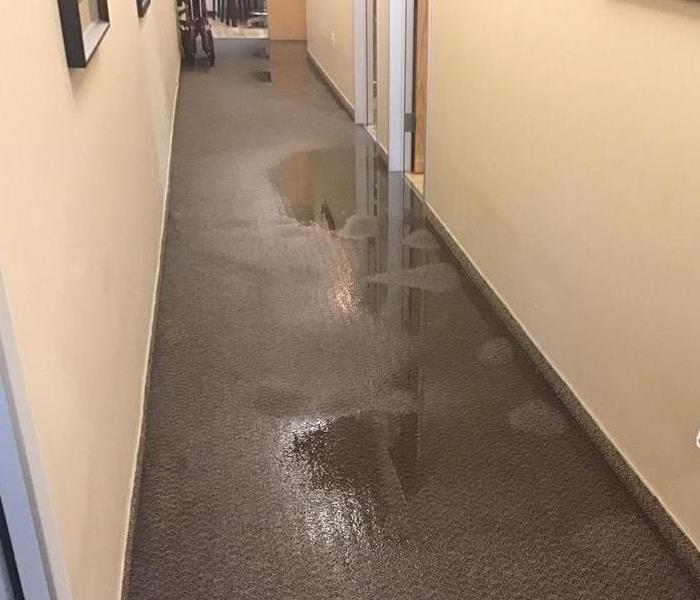 This hallway unfortunately suffered water damage and needed to be extracted right away.
This hallway unfortunately suffered water damage and needed to be extracted right away.
The water harm repair and cleanup prepare regularly includes a few steps to guarantee exhaustive reclamation. Here could be a common diagram of the method:
Crisis Reaction: Upon finding water harm, it's critical to address the circumstance instantly. Closed off the water source in the event that conceivable and contact a proficient water harm rebuilding company, such as SERVPRO, to start the crisis reaction prepare.
Review and Evaluation: The reclamation group will survey the degree of the water harm and decide the category and classification of the water (clean, gray, or dark water). This assessment makes a difference create an suitable rebuilding arrange.
Water Extraction: The another step is to expel overabundance water from the influenced range. Industrial-grade pumps, damp vacuums, and specialized gear are utilized to extricate standing water and minimize assist harm.
Drying and Dehumidification: After water extraction, the reclamation group will convey high-powered fans, discuss movers, and dehumidifiers to dry out the influenced zone. This step points to evacuate dampness from the discuss, dividers, floors, and other basic components to avoid form development and advance harm.
Rescue and Expulsion: Harmed materials and possessions that cannot be rescued are evacuated from the premises. This may incorporate carpets, furniture, drywall, separator, and other things that are past repair.
Cleaning and Sanitization: The influenced zone is completely cleaned and sanitized utilizing specialized cleaning operators to dispose of microscopic organisms, form, and other contaminants. This step guarantees a secure and clean environment.
Rebuilding and Repairs: Once the region is clean and dry, the rebuilding prepare starts. This includes repairing or supplanting harmed basic components, such as drywall, flooring, and separator. The objective is to reestablish the area to its pre-damaged condition.
Observing and Follow-up: All through the method, the reclamation group will screen the dampness levels to guarantee legitimate drying and address any potential issues. They may too give proposals for preventive measures to moderate future water harm dangers.
It's vital to note that the particular steps and term of the water harm repair and cleanup handle can change depending on the seriousness of the harm and the interesting circumstances of each circumstance. Enlisting a proficient water harm rebuilding company is suggested to guarantee effective and intensive reclamation.
Dallas Water Heater Leak Company SERVPRO of East Dallas
4/26/2023 (Permalink)
 Here are the effects of water damage when left untreated
Here are the effects of water damage when left untreated
Water Heater Break Water Damage Cleanup: What You Need to Know
A water heater is an essential appliance in most homes, providing hot water for showers, washing dishes, and doing laundry. However, when a water heater breaks, it can cause significant water damage to your home. Here's what you need to know about water heater break water damage cleanup.
Turn off the water supply and electricity to the water heater. The first step in cleaning up water damage from a water heater break is to turn off the water supply and electricity to the unit. This will prevent further damage and ensure your safety.
Call a professional water damage restoration company. Water damage from a water heater break can be extensive and difficult to clean up. It's best to call a professional water damage restoration company that has experience in handling these types of emergencies.
Remove standing water. The water damage restoration company will use specialized equipment to remove any standing water from your home. This includes pumps, vacuums, and dehumidifiers.
Dry out the affected area. After the standing water has been removed, the affected area will need to be dried out to prevent mold and mildew growth. The restoration company will use fans and dehumidifiers to dry out the area.
Assess the damage. The restoration company will assess the extent of the damage to your home and provide a detailed estimate for the cleanup and restoration process.
Remove damaged materials. Any materials that have been damaged beyond repair, such as drywall or carpeting, will need to be removed and replaced.
Clean and disinfect. The affected area will need to be cleaned and disinfected to prevent bacteria and mold growth. The restoration company will use specialized cleaning solutions to ensure that the area is safe and free of contaminants.
Restore your home. Once the cleanup process is complete, the restoration company will begin restoring your home to its preloss condition. This may include repairing or replacing damaged walls, flooring, or other materials.
In conclusion, a water heater break can cause significant water damage to your home. If you experience a water heater break, it's important to act quickly and call a professional water damage restoration company to help you with the cleanup and restoration process. They have the expertise and equipment necessary to handle the cleanup and ensure that your home is safe and free from contaminants.
Balch Springs Water Damage Cleanup Services
3/29/2023 (Permalink)
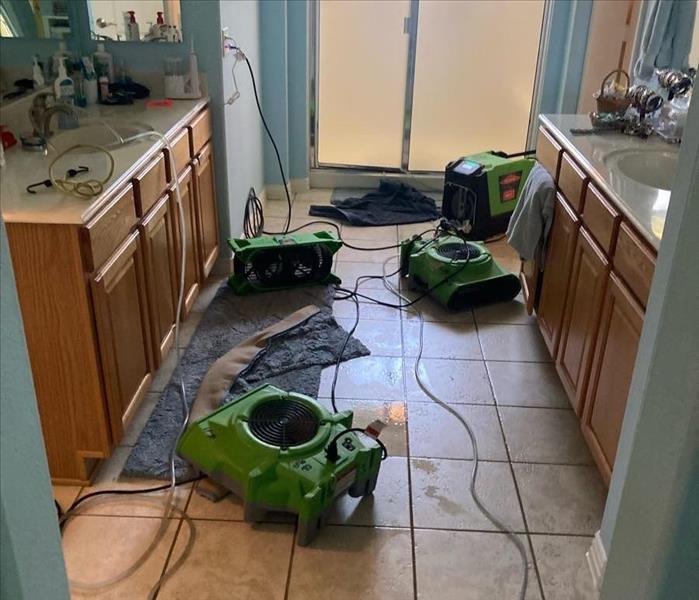 This Balch Springs home was a victim to a roof leak that brought rainwater inside.
This Balch Springs home was a victim to a roof leak that brought rainwater inside.
SERVPRO of Balch Springs has experience with water damage repair services. In Balch Springs there are tons of homes and businesses who might run into water damage issues. These issues can be caused by water pipes, water heater leaks, & roof leaks. Storm damage is known to ruin roofs and bring water into the home. This water can be deadly and ruin a home within seconds.
We have experienced technicians and equipment ready to be installed that can handle any size disaster. In Balch Springs we have seen ice storms, hail damage, and storm damage done to many homes. SERVPRO of Balch Springs is your trusted water damage clean up company. If you experience any water damage or you know someone who has please feel free to give us a call. We will be ready to help.
Balch Springs Trusted Water Damage Repair Team
2/21/2023 (Permalink)
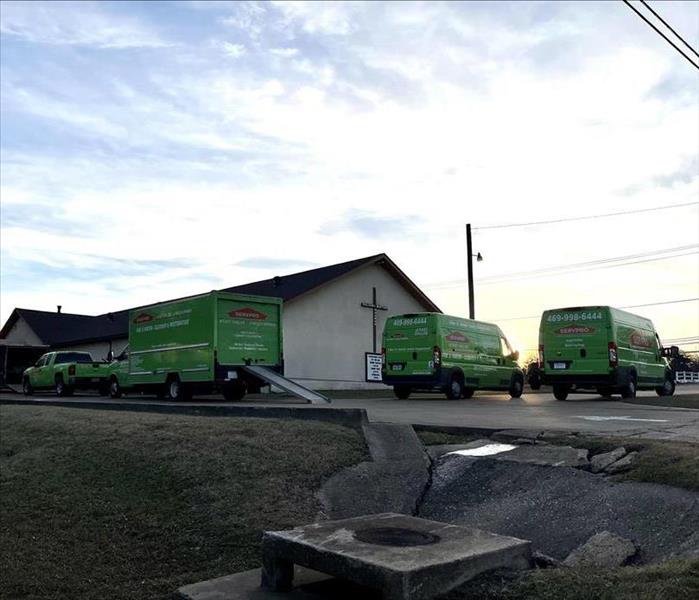 We were called out to a local Balch Springs church.
We were called out to a local Balch Springs church.
Balch Springs is a growing city in Dallas County, known for its diverse community, family-friendly neighborhoods, and access to nearby amenities. However, like any other city, Balch Springs is not immune to water damage caused by leaks or floods. If you experience water damage in your Balch Springs home or business, it's important to act quickly to prevent further damage and begin the water damage repair process.
The first step when dealing with water damage is to assess the damage and determine the source of the water. If the water damage is caused by a leaky pipe or appliance, the water supply to the affected area should be shut off to prevent further water from entering the space. If the water damage is caused by a flood or other natural disaster, it's important to take safety precautions and avoid the affected area until the water has receded.
Once the source of the water has been addressed, the next step is to begin the water damage repair process. This typically involves removing any standing water and drying out the affected area using specialized equipment, such as high-powered fans and dehumidifiers. It's important to remove water as quickly as possible to prevent mold growth, which can begin to form within 24 to 48 hours after the water damage has occurred.
If the water damage is extensive, it may be necessary to hire a professional water damage restoration company to handle the cleanup and repair process. These companies have the necessary equipment and expertise to thoroughly clean and dry out the affected area, as well as to repair any structural damage that may have occurred.
In addition to the immediate cleanup and repair process, it's important to take steps to prevent future water damage. This may include regular maintenance of plumbing and appliances, such as checking for leaks and ensuring that pipes and hoses are properly connected. It may also involve taking steps to protect your home or business from flooding, such as installing flood barriers or ensuring that your property is properly graded to divert water away from your building.
In conclusion, water damage can occur in any home or business, including in the growing city of Balch Springs. If you experience water damage, it's important to act quickly to prevent further damage and begin the water damage repair process. Taking steps to prevent future water damage can also help protect your property and prevent costly repairs in the future. To learn more about Balch Springs and its amenities, check out the official Balch Springs city website.
Here are some places that we have helped this past year!
- Official City of Balch Springs website: https://www.cityofbalchsprings.com/
- Balch Springs Chamber of Commerce: https://www.balchspringschamber.org/
- Balch Springs Parks and Recreation Department: https://www.cityofbalchsprings.com/147/Parks-Recreation
- Balch Springs Police Department: https://www.cityofbalchsprings.com/188/Police-Department
- Balch Springs Fire Department: https://www.cityofbalchsprings.com/182/Fire-Department
What To Do After A Dallas Water Flood
2/20/2023 (Permalink)
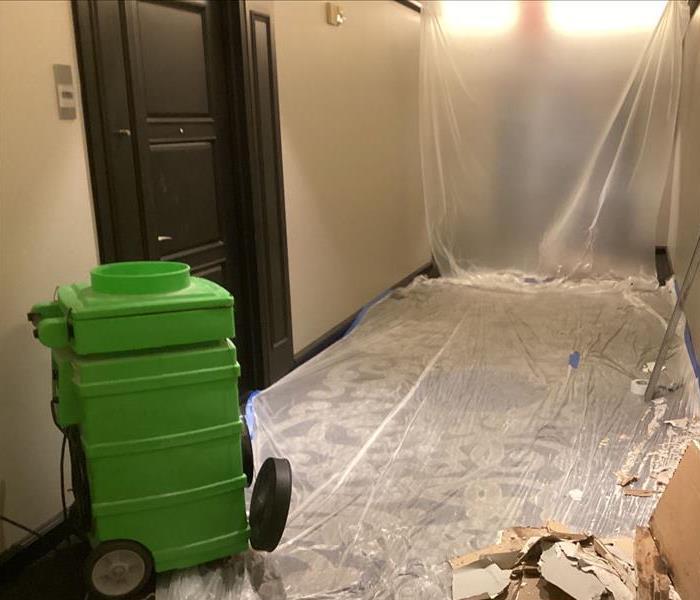 This Local East Dallas Apartment Suffered Heavy Water Damage Loss
This Local East Dallas Apartment Suffered Heavy Water Damage Loss
Water damage is a nightmare for any homeowner. Whether it's caused by a burst pipe, a leaking roof, or a natural disaster like a flood, water damage can cause serious problems for your home and your health. If you've experienced water damage, it's important to take action quickly to prevent further damage and restore your home to its preloss condition. In this blog, we'll discuss some tips and strategies for water damage repair that can help you get your home back on track.
Assess the Damage
The first step in water damage repair is to assess the damage. Take a careful look around your home and identify all areas that have been affected by water. Look for signs of water damage, such as water stains, mold growth, and dampness. If you're not sure where to start, consider hiring a professional water damage restoration company to perform an assessment.
Remove Standing Water
The next step is to remove any standing water from your home. If you have a significant amount of water in your home, you may need to use a pump to remove it. If the water damage is relatively minor, you may be able to use a wet/dry vacuum to suck up the water. Be sure to wear protective gear, such as gloves and boots, while doing this to avoid exposure to contaminated water.
Dry the Area
After you've removed the standing water, it's important to dry out the affected area as quickly as possible. Use fans and dehumidifiers to circulate air and remove moisture from the air. If you have access to natural sunlight, open windows and doors to allow fresh air in. This will help prevent mold growth and further damage to your home.
Clean and Disinfect
Once the affected area is dry, it's important to clean and disinfect it thoroughly. This will help prevent the growth of mold and bacteria, which can cause health problems for you and your family. Use a mixture of bleach and water to disinfect hard surfaces, such as floors and walls. Be sure to wear protective gear, such as gloves and a mask, while cleaning to avoid exposure to harmful chemicals.
Restore Your Home
Finally, it's time to restore your home to its preloss condition. This may involve replacing damaged materials, such as drywall and carpeting. Be sure to work with a reputable contractor who has experience in water damage restoration. They will be able to guide you through the restoration process and ensure that your home is safe and livable again.
Water damage can be a stressful and overwhelming experience for any homeowner. However, by taking action quickly and following these tips for water damage repair, you can restore your home and prevent further damage. Remember, the key is to act fast and work with a professional restoration company to ensure that your home is safe and healthy for you and your family.
Preventing Freeze Damage
2/1/2023 (Permalink)
 Stay warm during this freeze Dallas is experiencing.
Stay warm during this freeze Dallas is experiencing.
Keep garage doors closed, especially if there are water supply lines in the garage.
Open kitchen and bathroom cabinet doors to allow warmer air to circulate around the plumbing, especially if your sinks are on an exterior wall. (If you have small children, be sure to remove any harmful cleaners and household chemicals.)
Let the cold water drip from a faucet served by exposed pipes. Running water through the pipe—even at a trickle—helps prevent pipes from freezing.
Keep the thermostat set to the same temperature during day and night. Again, during a cold snap is not the time to set back the thermostat at night to save a few bucks on your heating bill.
If you plan to be away during cold weather, leave the heat on in your home, set to a temperature no lower than 55° F.
For the long term, add insulation to attics, basements, and crawl spaces. Insulation will maintain higher temperatures in those areas. And to prevent drafts, seal cracks and openings around windows, doors, and at sill plates, where the house rests on its foundation.
Balch Springs Water Damage Removal Team Shares Tips on Where Water Damage Starts
2/17/2022 (Permalink)
 Your Trusted Balch Springs Water Damage Removal Team is Here For Any Size Disaster.
Your Trusted Balch Springs Water Damage Removal Team is Here For Any Size Disaster.
There Are a Few Key Areas You Should Check for Damage in Your Balch Springs Home
Locating water damage and its sources is the first step in restoring your Balch Springs. Preferably, it would help if you had your home periodically inspected by professionals for water-related issues. However, there are some key places you can check on your own if you suspect a water problem.
When inspecting water damage spots in your Balch Springs home, SERVPRO technicians repeatedly find it in the same areas. They generally discover it near windows, in ceilings under leaky roofs, by pipe networks, around appliances, or beside water containers.
With all this in mind, some specific places you should check for water problems and associated damage are:
- The caulking around your window frames, your windows’ glass seals, and the areas beside and under your windows
- Attics, other spots directly under roofs, and places behind ceiling leaks or discolored structural elements
- Under sinks and around known pipe networks, especially after hard freezes, where leaky or burst pipes may occur
- or under washing machines, around the valves and gaskets of dishwashers, and near water heater tanks that haven’t been serviced in a while
- Around old or corroded water containers that may have been neglected for some time
Should you locate a water leak and related damage, you will likely need professional water damage remediation to help you with water cleanup and water damage repairs.
With that said, it is comforting to know that the highly trained and well-equipped water damage experts at SERVPRO of Balch Springs are just a phone call away. Contact us at (469)-998-6445 for assistance whenever you need us.
How Can I Restore My Balch Springs Home After A Flood Damage
10/12/2021 (Permalink)
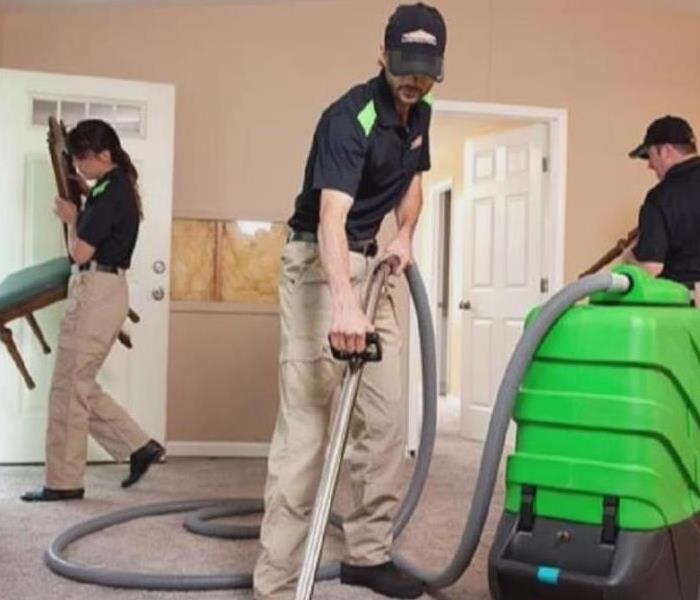 We have crews available to handle any water damage emergency.
We have crews available to handle any water damage emergency.
Hire SERVPRO Restoration Teams to Clean and Restore Your Balch Springs Home
Every Balch Springs home suffers after a disaster of any kind. Flooding, though, continues to cause problems until all of the water and the soaked, damaged property is removed from the home.
All SERVPRO has to do is Pump Out the Water, Right?
No, stopping Balch Springs flood damage only starts with water removal. SERVPRO technicians use the latest equipment available to rapidly pump out flooding from your home, but that won’t eliminate every threat. Our team members also draw water out of personal and structural property like sofas and wall panels, dispose of items too damaged for restoration, and spray every affected surface with an antibacterial agent to reduce threats and stop mold growth.
How Do You Get Water Out of Walls?
For paneling, technicians use the following devices to remove trapped moisture:
- Air Movers that generate a warm airflow which carefully pushes moisture out into the air without cracking or splitting drywall and other panels.
- Fans to draw the cool, moisture-filled air away from affected rooms, which speeds up the natural evaporation rate.
- Dehumidifiers to pull water out of the air, which increases the efficiency of the other devices.
Our restoration teams also use these devices to dry out sofas and other furniture. Team members place each piece on blocks or pallets and use the fans to increase air circulation all around them.
Why Is Flood Water a Risk?
Water that flows in from outside carries soil and other contaminants. SERVPRO technicians spray every surface affected by the flood to neutralize bacteria. This action, along with removing the water, also helps to reduce the possibility of mold growing inside your home, causing another disaster as we eliminate the first one.
 SERVPRO of East Dallas is a trusted leader in fire damage repair services.
We are located in Dallas, so we are able to reach Dallas quickly!
SERVPRO of East Dallas is a trusted leader in fire damage repair services.
We are located in Dallas, so we are able to reach Dallas quickly!




 24/7 Emergency Service
24/7 Emergency Service














